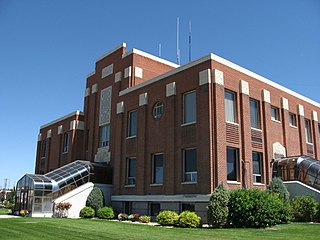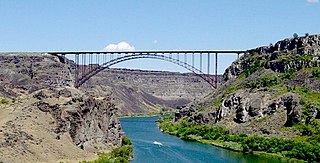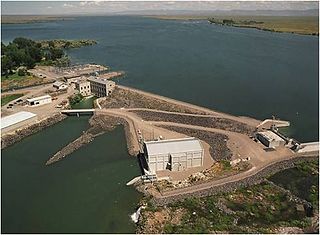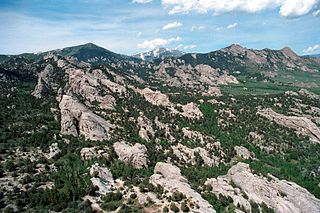Minidoka is a name of Dakota Sioux origin meaning "a fountain or spring of water". It is a name shared by several geographic locations in the Magic Valley region of southern Idaho in the United States:

Minidoka County is a county located in the U.S. state of Idaho. As of the 2010 census, the population was 20,069. The county seat and largest city is Rupert.

Cassia County is a county in the U.S. state of Idaho. As of the 2010 Census the county had a population of 22,952. The county seat and largest city is Burley.

Blaine County is a county in the U.S. state of Idaho. As of the 2010 United States Census, the population was 21,376. The county seat and largest city is Hailey. It is also home to the Sun Valley ski resort, adjacent to Ketchum.

Burley is a city in Cassia and Minidoka counties in the southern Idaho, United States. The population was 10,345 at the 2010 census. The city is the county seat of Cassia County.

Rupert is the county seat and largest city of Minidoka County, Idaho,. It is part of the Burley Micropolitan Statistical Area. The population was 5,554 at the 2010 census.

The Magic Valley is a region in south-central Idaho constituting Blaine, Camas, Cassia, Gooding, Jerome, Lincoln, Minidoka, and Twin Falls counties. It is particularly associated with the agricultural region in the Snake River Plain located in the area. The northern Magic Valley region — particularly Blaine and Camas Counties — is also known as the Wood River Valley after the Big Wood River.

Minidoka National Historic Site is a National Historic Site in the western United States. It commemorates the more than 9,000 Japanese Americans who were imprisoned at the Minidoka War Relocation Center during the Second World War.

Sawtooth National Forest is a National Forest that covers 2,110,408 acres in the U.S. states of Idaho and Utah. Managed by the U.S. Forest Service in the U.S. Department of Agriculture, it was originally named the Sawtooth Forest Reserve in a proclamation issued by President Theodore Roosevelt on May 29, 1905. On August 22, 1972 a portion of the forest was designated as the Sawtooth National Recreation Area (SNRA), which includes the Sawtooth, Cecil D. Andrus–White Clouds, and Hemingway–Boulders wilderness areas. The forest is managed as four units: the SNRA and the Fairfield, Ketchum, and Minidoka Ranger Districts.

The Minidoka Dam is an earthfill dam on the Snake River in south central Idaho. The dam, originally completed in 1906, is east of Rupert on county highway 400; it is 86 feet high and nearly a mile (1.6 km) in length, with a 2,400-foot (730 m) wide overflow spillway section. The dam and power plant were listed on the National Register of Historic Places in 1974. Walcott Park, close to the dam, is a popular summertime picnic area. Lake Walcott State Park and the headquarters for the Minidoka National Wildlife Refuge are adjacent to the dam.
Raft River National Forest was established as the Raft River Forest Reserve in Utah and Idaho on November 5, 1906 with 410,247 acres (1,660.21 km2). It became a National Forest on March 4, 1907 and was named after the Raft River Mountains, which it contained. On July 1, 1908 it was combined with Cassia National Forest to create Minidoka National Forest. The name was discontinued. The land is now part of Sawtooth National Forest as the Raft River Division of the Minidoka Ranger District.
Minidoka National Forest was established in Idaho and Utah on July 1, 1908 with 736,407 acres (2,980.13 km2) from consolidation of Cassia National Forest and Raft River National Forest, primarily in Idaho. On July 1, 1953 Minidoka was absorbed by Sawtooth National Forest and is now the Sawtooth's Minidoka Ranger District.

The Minidoka Project is a series of public works by the U.S. Bureau of Reclamation to control the flow of the Snake River in Wyoming and Idaho, supplying irrigation water to farmlands in Idaho. One of the oldest Bureau of Reclamation projects in the United States, the project involves a series of dams and canals intended to store, regulate and distribute the waters of the Snake, with electric power generation as a byproduct. The water irrigates more than a million acres (4,000 km²) of otherwise arid land, producing much of Idaho's potato crop. Other crops include alfalfa, fruit and sugar beets. The primary irrigation district lies between Ashton in eastern Idaho and Bliss in the southwestern corner of the state. Five main reservoirs collect water, distributing it through 1,600 miles (2,600 km) of canals and 4,000 miles (6,400 km) of lateral distribution ditches.
Empire School may refer to:

Minico High School, also known as Minidoka County High School, is a four-year public secondary school in Minidoka County, Idaho, operated by the Minidoka County Joint School District #331. The school colors are red and gold and the mascot is a Spartan.

The Albion Mountains are a mountain range in the U.S. states of Idaho (~99%) and Utah (~1%), spanning Cassia County, Idaho and barely reaching into Box Elder County, Utah. The highest point in the range is Cache Peak at 10,339 feet (3,151 m), and the range is a part of the Great Basin Divide and the Basin and Range Province. Most of the mountains are part of the Albion Division of the Minidoka Ranger District of Sawtooth National Forest.

Cache Peak, at 10,339 feet (3,151 m) above sea level, is the highest peak in the Albion Mountains of Cassia County in Southern Idaho. Cache Peak is located in the central part of the range southeast of Oakley and north of Almo in the Albion Division of the Minidoka Ranger District of Sawtooth National Forest.

The Black Pine Mountains are a mountain range in the U.S. states of Idaho (~65%) and Utah (~35%), spanning Cassia County, Idaho and reaching into Box Elder County, Utah. The highest point in the range is known as Black Pine Mountains High Point, sometimes referred to as Black Peak, at 9,395 feet (2,864 m), and the range is a part of the Great Basin Divide and the Basin and Range Province. In Idaho, the mountains are part of the Black Pine Division of the Minidoka Ranger District of Sawtooth National Forest.

Black Pine Mountains High Point, at 9,289 feet (2,831 m) above sea level is the highest peak in the Black Pine Mountains of Cassia County in southern Idaho. The high point is sometimes referred to as "Black Peak" because of a benchmark on the peak that reads "Black".

The Sublett Range is a mountain range in the U.S. states of Idaho (~94%) and Utah (~6%), spanning Cassia, Oneida, and Power counties, Idaho and reaching into Box Elder County, Utah. The Phosphoria Formation reaches its greatest thickness beneath the mountains.

Sublett Range High Point, at 7,492 feet (2,284 m) above sea level is the highest peak in the Sublett Range of Power County in southern Idaho. Sublett Range High Point is located in the east-central part of the range north of Snowville, Utah, and east of Malta, Idaho, and south of American Falls, Idaho in the Sublett Division of the Minidoka Ranger District of Sawtooth National Forest.